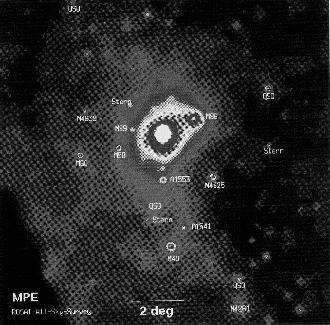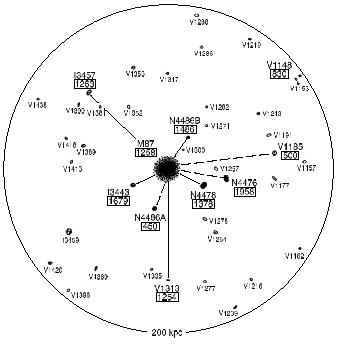


The absolute dominance, in terms of mass, of the M87 subclump in the Virgo cluster is not well
seen in the optical (Fig. 2, which
shows the luminosity distribution
of the cluster), but it becomes strikingly clear from an X-ray image of
the cluster. The reason for this is that, on the assumption
of hydrostatic equilibrium, the hot X-ray gas
is directly tracing the gravitational potential, i.e. the dark mass of the
system in which it is embedded.
In Fig. 5 we reproduce a ROSAT
All-Sky-Survey image of the Virgo cluster, which is identical in scale to the
optical image in
Fig. 2.
As mentioned by
Böhringer et
al. (1994),
who did the definitive study of
the X-ray properties of the Virgo cluster, there is good overall match
between the optical and
the X-ray, even in detail, note e.g. the relatively sharp Western edge
seen in the optical as well as in the X-ray. This means that the galaxies
and the hot gas are more or less in equilibrium. However,
there is this striking
difference in appearance of the M87 / M86 core structure. In the optical,
we note a swarm
of galaxies around M86 / M84, which of course is responsible for
shifting the optical center of the
cluster away from M87 (see Fig. 2),
while in the X-ray,
M87 is clearly the center of the cluster, or
more precisely: it is
clearly lying at the bottom of the most massive subclump.
This is evidence that
at least the core of the Virgo cluster is not in dynamical equilibrium. Our
interpretation of what is going on in the core has been mentioned before:
there is a smaller subclump around M86 which is falling into the dominating
M87 subclump from
the back
(Binggeli et al. 1993,
Böhringer et
al. 1994).
From the X-ray halos of M87, M86, and M49,
Böhringer et
al. (1994)
estimate several times 1014
M for the mass of the M87 subclump, and an order of magnitude
less for the mass of each of the M86 and M49 subclumps.
for the mass of the M87 subclump, and an order of magnitude
less for the mass of each of the M86 and M49 subclumps.

|
Figure 5. X-ray image of The Virgo cluster from the ROSAT All-Sky-Survey. Various foreground stars, quasars, Abell clusters, and Virgo cluster members (NGCs and Messiers) are indicated. The large, bright spot is centered on M87. The scale is identical to that of Fig. 2. Note the bright halos of M49, M86, and - very massive and dominating - M87. Courtesy of Dr. H. Böhringer and the MPE, Garching. |
The M87 / M86 subclump interaction will be further discussed below. Here we concentrate on the M87 subclump. Nulsen & Böhringer (1995) have used ROSAT data to calculate the mass profile of the M87 subclump (superceding, but more or less agreeing with, the classic study by Fabricant & Gorenstein 1983, based on Einstein data). Two components could be distinguished in the mass profile, one belonging to the galaxy M87 itself, which is in good accord with the masses indicated by the stars and the globular clusters of M87 (refs. given in Nulsen & Böhringer 1995), and one belonging to the subclump in which M87 is embedded. However, the mass (dark matter) profile is really continuous, and it would seem to be difficult to discriminate between ``M87 subclump'' galaxies that are gravitationally bound to M87 proper and others that are merely bound by the subclump as a whole. Nevertheless, this is what I have tried to do several years ago (Binggeli 1993), and I show some of this here because it gives me the opportunity to show the closer galaxy environment of M87.

|
Figure 6. Detailed map of the neighbourhood of M87 within a projected radius of 200 kpc. The size and morphology of the galaxies is schematically indicated (filled image = high surface brightness, open = low surface brightness, central dot = nucleus, irregular contour = irregular). Faint galaxies are identified by their VCC number (Binggeli et al. 1985). Possible satellites are connected to the center by lines. Figure from Binggeli (1993). |
Fig. 6 is a schematic of this environment,
within a projected radius of
200 kpc from M87. There are 41 Virgo cluster members in this area, only
10 of which have known velocities (including M87).
Most of these must be bound to
the M87 subclump; some might also belong to the M86
subclump. But what we can
try to do is to find those galaxies which are likely bound companions to the
galaxy M87, in the following way.
For a candidate companion we require, in addition
to the (pre-selected) small projected distance, d, a sufficiently
small velocity difference, | v |, to M87. These two quantities can
now be combined to give a ``projected mass'',
q = | v |2 . d / G. By averaging
q for N candidates, and multiplying the result with a
suitable constant
f that accounts for the distribution and projection of orbits, one gets
a ``projected mass'' estimate for the central object
(Bahcall & Tremaine 1981).
Since we know the mass profile of M87 from the X-ray halo, we can now add up possible
companions with growing q until the upper-limit X-ray mass from
Nulsen & Böhringer
(1995)
is exceeded, i.e. until the mass of M87,
at that average projected distance, needed to
bind the would-be companions becomes too large. With f = 24 /
 (cf.
Bahcall & Tremaine 1981),
I found five candidates in this way, which in combination give
a total ``projected mass'' for M87 at d
(cf.
Bahcall & Tremaine 1981),
I found five candidates in this way, which in combination give
a total ``projected mass'' for M87 at d
 85 kpc of
85 kpc of
 4 . 1012
M
4 . 1012
M , which is (made to
be) in accord with the X-ray mass of
M87 at that radius. These five candidates are listed
with their relevant
data in Table 2. Note also the smallness of their
relative luminosities,
which is a working condition for the method of
Bahcall & Tremaine (1981).
All five galaxies are, in fact, fairly compact in their appearance
(see Fig. 6); NGC 4486B, e.g., is legendary as a
M32-type compact elliptical; so they
are very probably companions to M87 indeed. However, two other
apparently good candidates,
NGC 4486A and NGC 4476, are certainly not real companions:
the ``projected mass'' of each of these galaxies alone far exceeds the
X-ray mass
limit. Many more of the remaining 30 dwarf galaxies with unknown galaxies
might be M87 satellites, of course.
, which is (made to
be) in accord with the X-ray mass of
M87 at that radius. These five candidates are listed
with their relevant
data in Table 2. Note also the smallness of their
relative luminosities,
which is a working condition for the method of
Bahcall & Tremaine (1981).
All five galaxies are, in fact, fairly compact in their appearance
(see Fig. 6); NGC 4486B, e.g., is legendary as a
M32-type compact elliptical; so they
are very probably companions to M87 indeed. However, two other
apparently good candidates,
NGC 4486A and NGC 4476, are certainly not real companions:
the ``projected mass'' of each of these galaxies alone far exceeds the
X-ray mass
limit. Many more of the remaining 30 dwarf galaxies with unknown galaxies
might be M87 satellites, of course.
| galaxy | type | L/LM87 | |  v | v |
| d | q |
| (km s-1) | (kpc) | (1012 M ) )
| |||
| VCC 1313 | BCD | 0.001 | 4 | 130 | << 0.01 |
| IC 3457 | dE3,N | 0.013 | 5 | 139 | << 0.01 |
| NGC 4478 | E2 | 0.094 | 120 | 55 | 0.18 |
| NGC 4486B | E1 | 0.013 | 228 | 46 | 0.55 |
| IC 3443 | dE0,Npec | 0.003 | 421 | 47 | 1.93 |
| d = projected distance to M87 | |||||
| q = ``projected mass'' (see text) | |||||